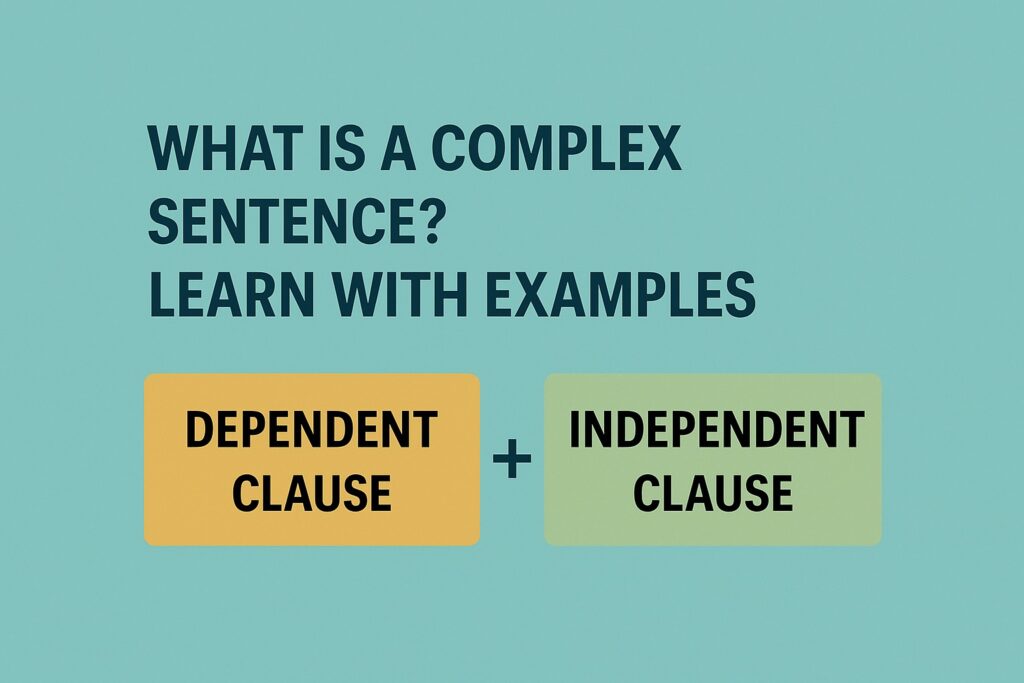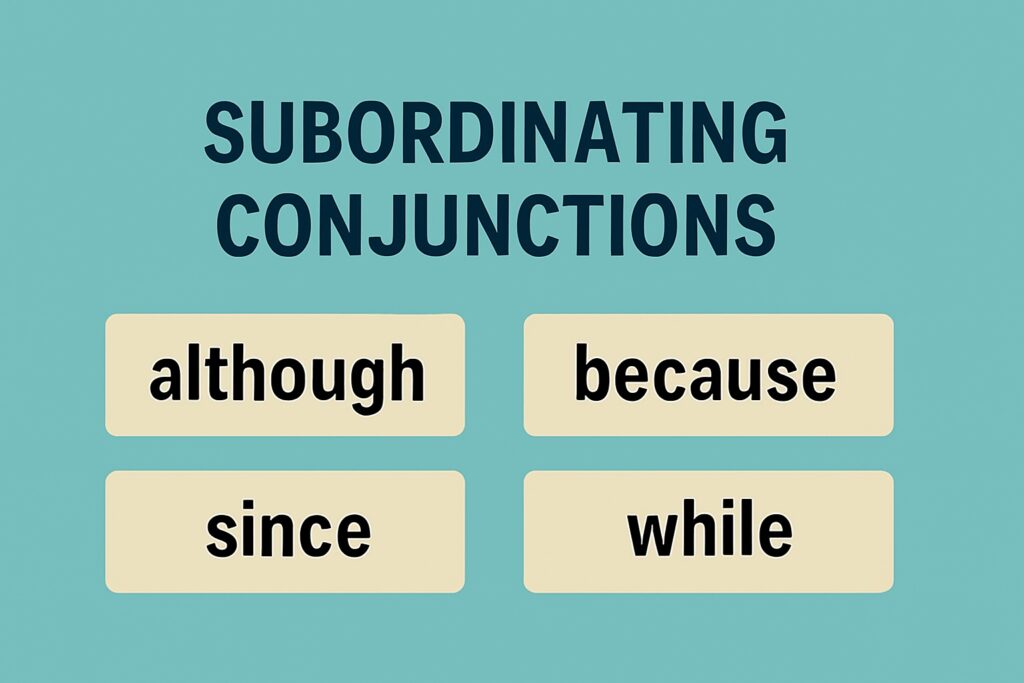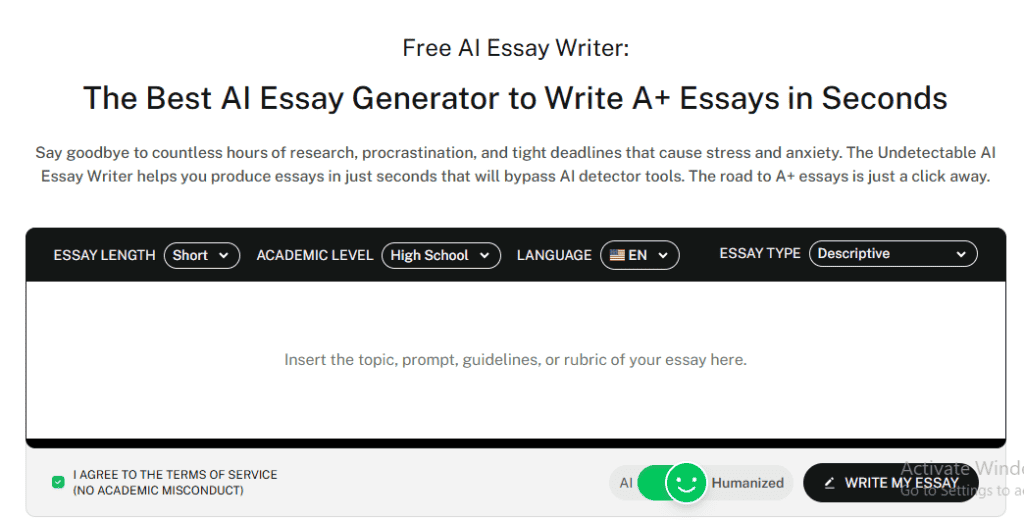English would be pretty boring if every sentence followed the same pattern. Imagine reading paragraph after paragraph of “I did this. I did that.”
Thankfully, we have different sentence structures in the language, i.e., simple, compound, complex, and compound-complex, to keep the writing varied and engaging.
A complex sentence joins one independent clause (a complete thought) with one dependent clause (an incomplete thought).
They’re the go-to structure when you want to explain cause and effect or contrast ideas.
In this article, I’ll talk about what is a complex sentence structure, how it differs from other sentence types, how to build it, and some bonus tips!
Key Takeaways
- A complex sentence combines one independent clause with one dependent clause, using a subordinating conjunction.
- The 5 components of a complex sentence include an independent clause, a dependent clause, a subordinating conjunction, punctuation based on clause order, and optional modifiers.
- Subordinating conjunctions are the glue that hold complex sentences together, and your choice of conjunction changes the meaning of the sentence.
- There are three main types of dependent clauses used in complex sentences: adverbial, adjective, and noun clauses.
What Is a Complex Sentence?

A complex sentence is a more detailed, layered type of sentence. It has two parts:
- A core message, known as an independent clause
- Some supporting detail that adds context to your message and doesn’t provide any meaning without the first part, also known as the dependent clause.
The second half isn’t a full sentence by itself, but it makes the first half richer and more specific.
Complex sentences are the antidote to dull, disconnected writing.


Never Worry About AI Detecting Your Texts Again. Undetectable AI Can Help You:
- Make your AI assisted writing appear human-like.
- Bypass all major AI detection tools with just one click.
- Use AI safely and confidently in school and work.
They are used to link ideas, show relationships between events, and add depth to a thought.
Key Elements: Independent Clause + Dependent Clause
An independent clause is the backbone of a complex sentence. It has both a subject and a verb and expresses a complete thought.
The independent clause is perfectly fine as a sentence by itself, but in a complex sentence, it works together with a dependent clause to form a detailed sentence.
A dependent clause also has a subject and a verb, but it starts with a word that instantly makes it incomplete.
Such words, like “although,” “because,” “since,” and “while,” are called subordinating conjunctions.
The moment you use one of these words, your sentence needs an independent clause to finish the thought.
Here are some complex sentence structure examples:
- She left early because she had another meeting.
- I’ll call you when I get home.
- Although he was tired, he finished the report.
How It Differs from Simple and Compound Sentences
A simple sentence is the shortest, easiest type of sentence. It uses just one independent clause and expresses one complete idea.
For example, I love coffee. One subject and one predicate that talk about one thought.
Compound sentences join two or more independent clauses using coordinating conjunctions such as and, but, or, so, and yet.
For example, you can go with me, or you can stay home. In this sentence, both sides of the comma could stand alone as separate sentences.
A complex sentence structure, on the other hand, blends one independent clause with one dependent clause.
These sentences show a relationship between the two ideas. For example, I like coffee because it helps me wake up.
If you’re unsure whether a sentence is simple, compound, or complex, you can check it using Ask AI.
Paste your sentence, and let it analyze its structure to determine which type it belongs to.
Components of a Complex Sentence
So far, I have mentioned the two main building blocks of a complex sentence, the independent clause and the dependent clause.
The independent clause is the main idea of a sentence, while the dependent clause adds supporting information and cannot exist without the first.
However, a complete complex sentence includes three other components that bring the structure together. They are:
- A subordinating conjunction that links the independent and dependent clauses while showing their relationship
- Additional modifiers, which aren’t compulsory, but they make a sentence more vivid. They can include adjectives or adverbs.
Subordinating Conjunctions: The Glue of Complexity
A subordinating conjunction holds the two clauses of a complex sentence together. Without it, the two clauses wouldn’t have a clear, logical relationship.
It turns two separate thoughts into one smooth, connected sentence.

Common Examples (although, because, since, while)
Below are ten of the most commonly used subordinating conjunctions. You’ve definitely seen these before, but here’s a refresher list:
- Because
- Although
- Since
- Unless
- If
- When
- After
- Before
- Even though
How They Connect Ideas
Subordinating conjunctions join together the dependent clause and the independent clause.
In addition to joining two clauses to make one sentence, they also define a relationship between them.
Let’s understand it with an example.
“I stayed home. It was raining.” These are two sentences with different contexts, and anyone reading them has to guess whether the rain was the reason you stayed home, just a coincidence, or something entirely unrelated.
When a subordinating conjunction is added to join these sentences, as in, “I stayed home because it was raining,” the reader now knows that the second clause establishes a reason why you stayed home.
Meaning Shifts Based on Conjunction Choice
Changing just one subordinating conjunction often modifies the entire meaning of your sentence.
Here’s a fun exercise to help you understand it better:
In the sentence below, try filling in the blank with different subordinating conjunctions we discussed earlier:
“I took the job ___ I needed the money.”
Examples:
- Because → I took the job because I needed money.
- Although → I took the job despite needing the money (maybe it didn’t pay well!).
- Even though → I took the job even though I needed money (The sentence shows stronger contrast, it implies you really didn’t want to, but you did anyway.)
Notice how changing the joining word affects how your reader interprets your attitude towards the action.
Types of Dependent Clauses
By now, you already know that complex sentences are made up of independent and dependent clauses.
There are three main types of dependent clauses you’ll regularly see in complex sentences: adverbial clauses, adjective clauses, and noun clauses.
- The adverbial clauses function exactly like an adverb. They describe when, why, where, or under what condition an action described in an independent clause happens.
For example, “Because I was tired, I skipped the party.”
- The adjective clauses describe a noun or pronoun, i.e., the person or thing who performs an action. In both of those examples below, the dependent clause gives more info about the noun just before it.
- The book that I borrowed from the library was amazing.
- She’s the teacher who gave me extra help.
- Lastly, the noun clauses are just like regular nouns. You can use them as the subject, object, or complement in a sentence. For instance:
- What you said was surprising. (subject of the sentence)
- I don’t know what he wants. (object of the verb “know”)
Sometimes, even when we know the types of clauses, our sentences still come out sounding flat, and Undetectable AI’s AI Essay Writer will come in handy at such instances.
Drop your content into the tool and have it rework your text into more complex, natural-sounding sentences.

Punctuation Rules for Complex Sentences
Complex sentences follow some pretty clean punctuation rules based on the position of dependent and independent clauses.
Here are the three basic rules of punctuation for complex sentences:
- If the dependent clause comes first, slap a comma after it.
When you start with the less important (dependent) part of the sentence, the reader needs a signal, i.e, a comma, that the main idea is coming next. (Example: When the meeting ended, everyone rushed out for coffee.)
- If the independent clause comes first, skip the comma.
If you start with the main idea, you don’t need to separate the clauses with a comma. (Example: Everyone rushed out for coffee when the meeting ended.)
- Mid-sentence dependent clauses need a pair of commas
And when a dependent clause pops up in the middle of a sentence and interrupts your flow, you use commas around it. (Example: The book, although a bit outdated, still had useful tips.)
Grammar learners often get tripped up by comma placement in complex sentences.
If you’re ever in doubt about the punctuation in your sentences, use a grammar checker for complex sentence structure to fix your errors and learn as you go.
Common Mistakes with Complex Sentences
It is fairly easy to mess up the grammar and punctuation in complex sentences if you’re not careful.
Here are some of the most common mistakes people make:
- Starting a sentence with a dependent clause and forgetting the comma
- Using a coordinating conjunction (like “and” or “but”) instead of a subordinating one
- Putting a dependent clause alone as a sentence (a sentence fragment)
- Using too many dependent clauses in one sentence
- Overusing the same subordinating conjunction
Complex vs Compound vs Compound-Complex Sentences

A compound sentence is basically two complete thoughts joined by a coordinating conjunction. For example, I love coffee, and I drink it every morning.
Each side of the sentence could stand alone, but they’re joined together. Simple enough.
It differs from a complex sentence such that both clauses are independent. Whereas complex sentences have one dependent and one independent clause.
And then we have the compound-complex sentence structure, that has at least two independent clauses and at least one dependent clause.
Naturally, such sentences are longer than compound or complex sentences.
For example: Although it started raining, I still went for a walk, and I grabbed an umbrella just in case.
Now you’ve got a dependent clause (Although it started raining) and two independent clauses (I still went for a walk, and I grabbed an umbrella just in case).
The table below summarizes the difference between these sentence types:
| Sentence Type | Structure | Example |
| Compound | Independent + Independent | “She runs, and he only walks daily.” |
| Complex | Independent + Dependent | “She runs because she loves it.” |
| Compound-Complex | 2 Independent + 1 Dependent | “She runs because she loves it, and he only walks daily.” |
Access our AI Detector and Humanizer directly through the widget below.
Final Thoughts
Complex sentences can oftentimes feel… well, complex. But it’s only natural to feel that way, especially if you are starting to understand the grammar rules and structures.
Undetectable AI is an all-in-one writing assistant built for writers, students, professionals, marketers, or anyone trying to learn English with hands-on support.
Here are some classic features of the tool that will help you master complex sentence structure usage:
- Grammar checker to spot and fix any errors in your writing
- AI essay writer that creates structured, well-organized content using a mix of sentence types
- Paraphraser to rewrite long or repetitive complex sentences into simpler ones
- Humanizer that adjusts sentence structure so it reads as if written by a real person, with a natural rhythm
- Plagiarism Checker to ensure your content is safe to publish and submit
With Undetectable AI’s AI Essay Writer and Grammar Checker, you can refine your complex sentences and make your writing clearer and more professional.
Sign up at Undetectable AI now to explore these tools!
